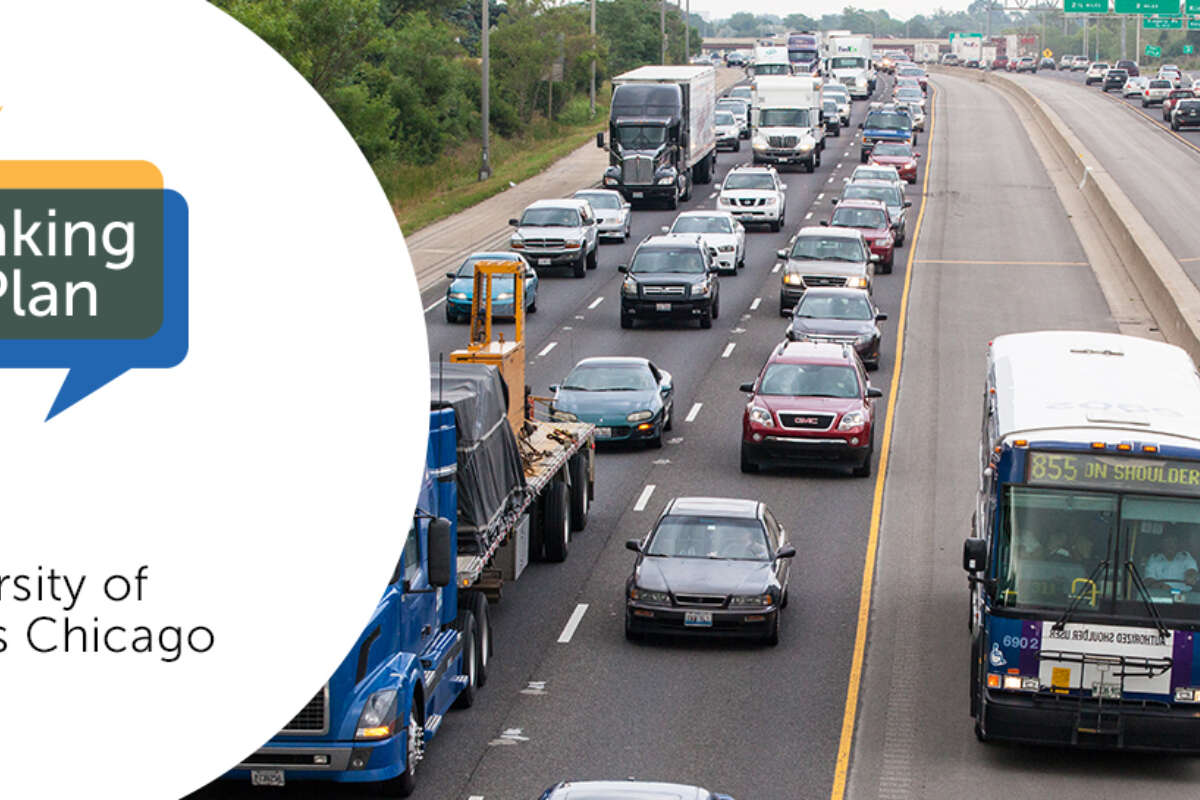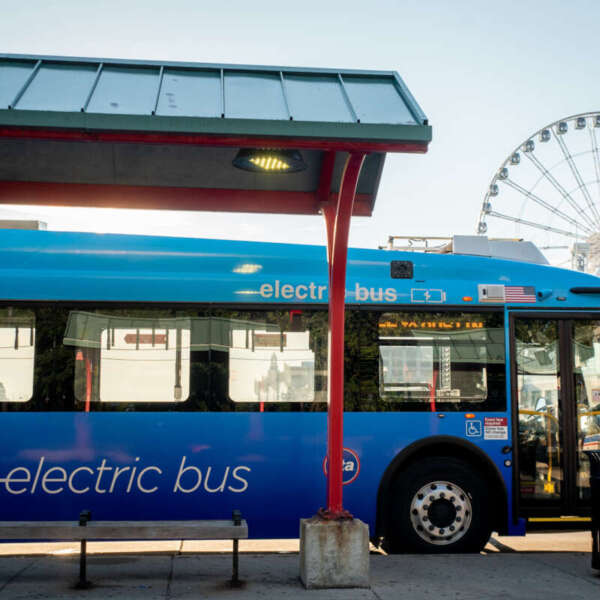Guest Blogger, UIC Professor Kate Lowe suggests radical rethinking of transit’s future
November 2, 2021
November 2, 2021

 The RTA is currently developing the 2023 Regional Transit Strategic Plan for Northeastern Illinois at a time when the challenges and opportunities facing our region’s transit system have never been greater. Making a Plan represents our effort to engage and collaborate with close stakeholders and the public. We have invited a group of transit users and thinkers to answer a set of questions for an occasional guest series on Connections, the RTA blog. The views represented in this series are not those of the RTA, but they are views we want to hear and have heard. If you have thoughts about this post, the strategic plan, or would like to participate by contributing a guest blog post, please email communications@rtachicago.org and subscribe to our newsletter to learn more.
The RTA is currently developing the 2023 Regional Transit Strategic Plan for Northeastern Illinois at a time when the challenges and opportunities facing our region’s transit system have never been greater. Making a Plan represents our effort to engage and collaborate with close stakeholders and the public. We have invited a group of transit users and thinkers to answer a set of questions for an occasional guest series on Connections, the RTA blog. The views represented in this series are not those of the RTA, but they are views we want to hear and have heard. If you have thoughts about this post, the strategic plan, or would like to participate by contributing a guest blog post, please email communications@rtachicago.org and subscribe to our newsletter to learn more.
Name: Kate Lowe
Organization or Affiliation: University of Illinois Chicago
Role/Responsibilities: Associate Professor
Favorite transit mode or station? Too many favorites to pick one!
Why are you passionate about transit? Transit makes cities possible! It’s crucial for our environment, mobility justice, joyful urban living, and our collective future.
What do you see as the greatest challenges and opportunities for the Chicago region’s transit system over the next ten years? What is the biggest barrier to realizing these opportunities?
The status quo that prioritizes private vehicles and associated land use patterns continues to be a tremendous challenge for transit. In the region, there is a large time gap—on average—between commuting by car and transit. Instead of focusing on closing this modal inequity, some agencies still try to speed car travel, instead of prioritizing a level playing field for safer and more sustainable modes, like transit.
The region has the opportunity to radically rethink safety on transit. In community based research with Equiticity and the Metropolitan Planning Council, we found many residents in Black and Brown communities avoid transit because of public violence, while also facing discriminatory and potentially violent policing. Investing in people and communities can help make them and transit safer by addressing root causes of violence and can be combined with transit specific interventions proposed by the Alliance for Community Transit in Los Angeles.
Tell us your ideas for improving access to transit within the Chicago region and what policy levers or partnerships might be required to make the changes you envision?
The CTA Red Line Extension and restructuring service and fares on Metra remain important rail improvements, but major bus service improvements are critical to enhance access to quality transit. Pace and the CTA have experimented with strategies to give buses better/exclusive rights-of-way; these could be dramatically expanded and combined with signal priority, increased frequency, and express service (without cutting local service). Partnerships with municipalities and the Illinois Department of Transportation will be vital for this.
Another strategy that could enhance bus service is fareless service. Payment slows down buses and can cause conflict between drivers and riders. Eliminating fares would provide financial benefit (without potentially problematic means testing) to bus riders who are disproportionately (but not exclusively) low and moderate income. Some counter that farefree bus service will attract more riders whose boarding time will negate the speed improvements—if that is the case, more people are benefiting from buses.
Looking ahead, what future force of change has the greatest potential to transform or disrupt our region’s transit system?
Before the pandemic, at the national level, working from home already accounted for a larger share of workers than commuting by transit did. We will see some return to in person work, but likely more varied schedules and not at the same level. Work trips account for a declining minority of all trips, and together these trends demonstrate the opportunity and challenge of changing a system that often had commuting as a focus.
Decades of underfunding have left the transit system in a constant state of austerity. Tradeoffs are almost always necessary when making decisions about improvement and expansion of the system. How do you recommend investing in the system to achieve the greatest regional impact?
My post has definitively added numerous potential costs amid a constrained financial landscape. A multi-prong and multi-level approach needs to recognize transit agencies can make some important shifts toward greater equity. Yet, a whole range of stakeholders must act to dramatically change the local, state and federal landscape for funding and policies within public transit (as outlined in this UIC Urban Forum White Paper) and beyond (all transportation modes, land use, and investment) for maximum regional impact. A guiding principle needs to be expanded accessibility over ridership, targeting Black and Brown low and moderate-income groups and revisiting regional funding allocations. This will be a shift from primarily relying on race-neutral ridership targets that the farebox recovery ratio encourages. This change in goals and metrics will enhance equity and further advance the system that can provide the service that is necessary but not sufficient to maximize transit environmental, livability and prosperity benefits.
What models of successful transit funding can we look to for guidance as we seek to make our funding streams more sustainable?
Public transit is necessary public good. Federal funds play an important role, but are generally restricted to capital rather than operating costs. A sustainable model would mean a sea change at the federal level and state with increased transit dollars that could be more flexibly used in all regions—increased dollars and support for operating uses that center equity and explicitly examine racial impacts of financial models.
What can we learn from efforts to advance equity in other public spheres and apply to transit to make a tangible difference?
People do not live in policy silos. Lived experiences cross many spheres, including but not limited to community development, public safety, housing, health care, employment, and public transit. Identities are intersectional based on but not limited to gender, race, income, and disability. Public transit solutions must center the realities of these interconnections to address equity and improve services in partnership across the spheres simultaneously. This is not an easy feat, but will help mean vital transit improvements come with community investment without displacement, as one example.
Subscribe to our Newsletter
Related Articles
 New stations on CTA Green Line, Metra UP-N line increase transit access for residents, riders
New stations on CTA Green Line, Metra UP-N line increase transit access for residents, riders
In 2024, CTA and Metra opened two new stations: the Damen station in Chicago’s Near West Side neighborhood along CTA’s Green Line and the Peterson/Ridge stat...
January 28, 2025 2025 Regional transit budget available for public comment, foreshadows risk to system’s future without fiscal cliff solution
2025 Regional transit budget available for public comment, foreshadows risk to system’s future without fiscal cliff solution
The RTA has released the 2025 Regional Transit Operating Budget and Five-Year Capital Program for download and public comment. The budget comes as an operati...
November 15, 2024 With equity at the forefront, CTA, Metra, and Pace open new facilities, prioritize upgrades in south and west communities
With equity at the forefront, CTA, Metra, and Pace open new facilities, prioritize upgrades in south and west communities
This year, CTA and Pace have opened or advanced various new facilities in south and west communities throughout the region, and Metra has prioritized upgrade...
October 9, 2024 New project management oversight report highlights more than 100 projects representing $8.2 billion in capital investments
New project management oversight report highlights more than 100 projects representing $8.2 billion in capital investments
The RTA’s Project Management Oversight (PMO) program ensures that the Service Boards—CTA, Metra, and Pace—are spending capital funds and managing their infra...
June 27, 2024 Transportation Tuesday recap: Improving and expanding the transit system strategically
Transportation Tuesday recap: Improving and expanding the transit system strategically
With last year’s adoption of Transit is the Answer came 15 new evaluation metrics that comprise a strategy for evaluating and selecting capital projects. Now...
May 30, 2024 Transit is the answer to meeting Illinois’ climate goals
Transit is the answer to meeting Illinois’ climate goals
As we celebrate Earth Day 2024, the RTA is announcing Transforming Transit —the agency’s commitment to lead the Chicago region’s transit system into the futu...
April 18, 2024